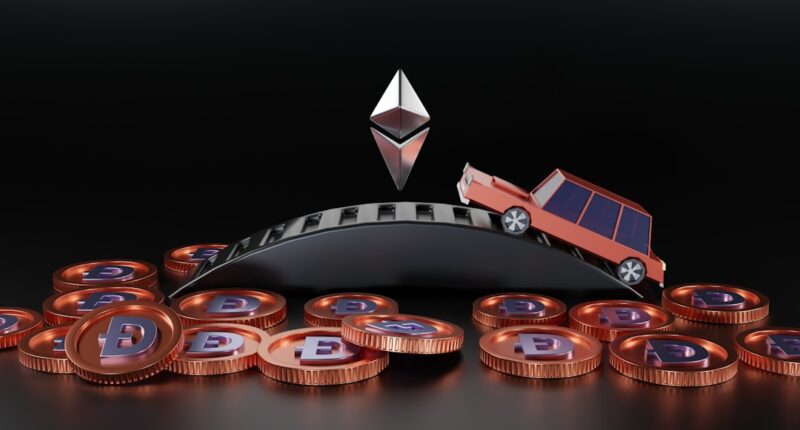The blockchain industry has experienced significant growth and innovation in recent years, with numerous platforms vying for dominance in the decentralized space. Two of the most popular and widely recognized blockchain platforms are Solana and Ethereum. While both platforms offer similar functionalities, they have distinct differences that set them apart. This article will explore the basics of Solana and Ethereum, their advantages and strengths, their tokenomics, developer communities, dApps and use cases, NFTs and gaming ecosystems, recent developments, and predictions for the future.
Key Takeaways
- Solana and Ethereum are two of the most popular blockchain platforms in the market.
- Solana is faster and more scalable than Ethereum, making it a preferred choice for developers.
- Ethereum’s strength lies in its security and decentralization, making it a reliable platform for transactions.
- SOL and ETH have different tokenomics, with SOL having a fixed supply and ETH having a variable supply.
- The battle for talent between the developer communities of Solana and Ethereum will shape the future of both platforms.
The Basics: Understanding Solana and Ethereum
Solana and Ethereum are both blockchain platforms that enable the development of decentralized applications (dApps) and the execution of smart contracts. However, they differ in terms of their architecture, consensus mechanisms, programming languages, token economies, and governance models.
Solana is a high-performance blockchain platform designed for scalability and speed. It utilizes a unique consensus mechanism called Proof of History (PoH), which enables fast transaction processing by providing a historical record of all events on the network. Solana’s architecture is based on a combination of Proof of Stake (PoS) and Byzantine Fault Tolerance (BFT), allowing it to achieve high transaction throughput.
On the other hand, Ethereum is the pioneer of smart contract platforms and is known for its robust ecosystem and wide range of use cases. Ethereum uses a consensus mechanism called Proof of Work (PoW), which requires miners to solve complex mathematical problems to validate transactions. However, Ethereum is in the process of transitioning to a more energy-efficient consensus mechanism called Proof of Stake (PoS) through the Ethereum 2.0 upgrade.
In terms of programming languages, Solana primarily uses Rust for smart contract development, while Ethereum supports Solidity as its native programming language. This difference in programming languages can impact developer adoption and ease of development on each platform.
Speed and Scalability: Solana’s Advantages Over Ethereum
One of the key advantages of Solana over Ethereum is its scalability. Solana’s unique approach to scalability allows it to process thousands of transactions per second, making it one of the fastest blockchain platforms in the industry. This high transaction throughput is achieved through its combination of PoS and BFT consensus mechanisms, as well as its innovative use of PoH.
In comparison, Ethereum has faced scalability challenges due to its PoW consensus mechanism. The current version of Ethereum can process around 15 transactions per second, which is significantly lower than Solana’s throughput. However, Ethereum’s upcoming upgrade to Ethereum 2.0 aims to address these scalability issues by transitioning to a PoS consensus mechanism and implementing shard chains.
Furthermore, Solana’s transaction costs are generally lower than Ethereum’s. Ethereum has faced issues with high gas fees during periods of network congestion, making it less cost-effective for certain use cases. Solana’s low transaction costs make it attractive to developers and businesses looking for a more affordable blockchain solution.
Security and Decentralization: Ethereum’s Strengths in Comparison
| Metrics | Ethereum | Comparison |
|---|---|---|
| Security | Uses a proof-of-work consensus algorithm, which makes it difficult for attackers to manipulate the blockchain. | Other blockchain platforms may use less secure consensus algorithms, making them more vulnerable to attacks. |
| Decentralization | Has a large and diverse network of nodes, making it difficult for any one entity to control the network. | Other blockchain platforms may have a smaller network of nodes, making them more centralized and vulnerable to control by a single entity. |
| Smart Contracts | Ethereum’s smart contract functionality allows for the creation of decentralized applications (dApps) and the execution of complex transactions. | Other blockchain platforms may not have the same level of smart contract functionality, limiting their potential use cases. |
| Community | Ethereum has a large and active community of developers and users, constantly working to improve the platform. | Other blockchain platforms may have a smaller or less active community, limiting their potential for growth and development. |
While Solana excels in speed and scalability, Ethereum has established itself as a secure and decentralized blockchain platform. Ethereum’s security features, such as its robust smart contract language Solidity and its extensive auditing processes, ensure that dApps built on the platform are secure and resistant to attacks.
Ethereum also prioritizes decentralization, with a large and active community of developers and validators spread across the globe. The platform’s focus on decentralization ensures that no single entity has control over the network, making it resistant to censorship and manipulation.
In comparison, Solana’s security features are still being tested and audited by the community. While Solana has implemented various security measures, including bug bounties and audits, it is still relatively new compared to Ethereum and may face challenges in establishing the same level of security and decentralization.
Tokenomics: Comparing SOL and ETH
Both Solana and Ethereum have their native tokens that play a crucial role in their respective ecosystems. Solana’s native token is called SOL, while Ethereum’s native token is called ETH.
SOL is used for various purposes within the Solana ecosystem, including staking, transaction fees, and governance. Staking SOL allows users to participate in the network’s consensus mechanism and earn rewards. Transaction fees on Solana are paid in SOL, which helps incentivize validators to secure the network. Additionally, SOL holders have the power to vote on governance proposals and influence the direction of the platform.
ETH, on the other hand, serves as the fuel for the Ethereum network. It is used to pay for transaction fees, deploy smart contracts, and participate in decentralized finance (DeFi) applications. ETH holders can also stake their tokens in Ethereum 2.0 and earn rewards for securing the network.
In terms of token economics, SOL has a fixed supply of 489 million tokens, while ETH has a maximum supply limit of 18 million per year. The distribution of SOL tokens is relatively more centralized compared to ETH, with a significant portion held by the Solana Foundation and early investors. ETH has a more decentralized distribution, with a large number of holders spread across the Ethereum ecosystem.
Developer Community: The Battle for Talent

The developer community plays a crucial role in the growth and adoption of blockchain platforms. Both Solana and Ethereum have vibrant developer communities, but they differ in terms of size, activity, and diversity.
Ethereum has a well-established and active developer community that has been growing since its inception. The Ethereum community consists of developers from various backgrounds, including blockchain enthusiasts, software engineers, and entrepreneurs. The community is known for its open-source ethos and collaborative nature, with developers constantly sharing knowledge, building tools, and contributing to the ecosystem.
Solana’s developer community is relatively smaller compared to Ethereum but has been rapidly growing in recent years. Solana has been actively working to attract developers by offering grants, hackathons, and developer resources. The Solana community is known for its technical expertise and focus on scalability, attracting developers interested in building high-performance dApps.
DApps and Use Cases: Which Blockchain Reigns Supreme?
The number and quality of dApps and use cases built on a blockchain platform are key indicators of its adoption and success. Both Solana and Ethereum have seen significant growth in terms of dApps and use cases, but they differ in terms of quantity, quality, and diversity.
Ethereum has a wide range of dApps and use cases across various industries, including decentralized finance (DeFi), non-fungible tokens (NFTs), gaming, supply chain management, and more. The Ethereum ecosystem has been the birthplace of many successful projects, such as Uniswap, Aave, and CryptoKitties. The platform’s robust smart contract capabilities and extensive developer tools have made it a popular choice for developers looking to build decentralized applications.
Solana’s dApp ecosystem is still growing but has gained traction in certain areas, particularly in the NFT and gaming sectors. Solana’s speed and scalability advantages make it attractive to developers looking to build high-performance gaming experiences and NFT marketplaces. Projects like Serum, Mango Markets, and Star Atlas have gained popularity on Solana for their innovative use of the platform’s capabilities.
NFTs and Gaming: Ethereum’s Dominance Challenged by Solana
NFTs (non-fungible tokens) and gaming have emerged as major use cases for blockchain technology in recent years. Ethereum has been the dominant platform for NFTs and gaming due to its established ecosystem, developer tools, and network effects. Projects like CryptoPunks, NBA Top Shot, and Axie Infinity have gained widespread popularity on Ethereum.
However, Solana’s advantages in speed and scalability have made it an attractive alternative for NFT and gaming developers. Solana’s fast transaction processing allows for seamless and interactive gaming experiences, while its low transaction costs make it more accessible for users. Solana-based projects like Degenerate Ape Academy, SolPunks, and Solanart have gained attention for their innovative use of NFTs and gaming on the platform.
Recent Developments: ETH News and SOL Updates
Both Ethereum and Solana have seen significant developments and updates in recent months. Ethereum’s most notable development is the ongoing transition to Ethereum 2.0, which aims to address the platform’s scalability issues through the implementation of shard chains and a PoS consensus mechanism. The Ethereum community has also been actively working on layer 2 solutions, such as Optimism and Arbitrum, to improve scalability in the short term.
Solana has also made significant progress in terms of adoption and development. The platform has seen a surge in new projects and partnerships, with notable collaborations with FTX, Serum, and Mango Markets. Solana has also been actively working on improving its developer experience by launching developer tools, hackathons, and grants programs.
The Future: Predictions for Solana and Ethereum in the Blockchain Landscape
The future of Solana and Ethereum in the blockchain landscape is promising but also highly competitive. Both platforms have their unique strengths and advantages that will continue to attract developers, businesses, and users.
Solana’s focus on speed and scalability positions it as a strong competitor to Ethereum, particularly in the NFT and gaming sectors. As more developers recognize the benefits of Solana’s high-performance capabilities, we can expect to see an increase in innovative dApps and use cases built on the platform. However, Solana will need to address security concerns and continue to build a robust developer community to compete with Ethereum’s established ecosystem.
Ethereum, on the other hand, has a strong foundation and network effects that will continue to drive its growth and adoption. The transition to Ethereum 2.0 will significantly improve scalability and reduce transaction costs, making it more competitive with Solana in terms of speed and cost-effectiveness. Additionally, Ethereum’s extensive developer community and wide range of use cases give it a significant advantage in the blockchain landscape.
In conclusion, Solana and Ethereum are two of the most popular blockchain platforms in the industry, each with its own strengths and advantages. While Solana excels in speed and scalability, Ethereum prioritizes security and decentralization. Both platforms have vibrant developer communities and a growing number of dApps and use cases. The future of Solana and Ethereum will be shaped by their ability to address scalability challenges, attract developers, and meet the evolving needs of the blockchain ecosystem.
If you’re interested in learning more about the ongoing debate between Solana and Ethereum, you might find this article on ETH News quite informative. Titled “Hello World: A Comprehensive Comparison of Solana and Ethereum,” it delves into the key differences and similarities between these two prominent blockchain platforms. To gain a deeper understanding of their respective strengths and weaknesses, click here to read the full article.
FAQs
What is Solana?
Solana is a blockchain platform that aims to provide fast and scalable transactions with low fees. It was launched in 2017 by Solana Labs and uses a unique consensus algorithm called Proof of History (PoH).
What is Ethereum?
Ethereum is a blockchain platform that allows developers to build decentralized applications (dApps) and smart contracts. It was launched in 2015 by Vitalik Buterin and has become one of the most popular blockchain platforms in the world.
What are the main differences between Solana and Ethereum?
Solana and Ethereum differ in their consensus algorithms, transaction speeds, and fees. Solana uses PoH, which allows for faster and more scalable transactions, while Ethereum uses Proof of Work (PoW) and is currently transitioning to Proof of Stake (PoS). Solana also has lower transaction fees compared to Ethereum.
Which platform is better for developers?
Both Solana and Ethereum have their own advantages and disadvantages for developers. Solana’s fast transaction speeds and low fees make it attractive for developers building high-frequency trading applications, while Ethereum’s large developer community and established ecosystem make it a popular choice for building dApps and smart contracts.
Which platform has more users?
As of August 2021, Ethereum has a larger user base compared to Solana. Ethereum has over 200 million unique addresses, while Solana has around 10 million unique addresses.
Which platform has more market capitalization?
As of August 2021, Ethereum has a larger market capitalization compared to Solana. Ethereum’s market cap is around $300 billion, while Solana’s market cap is around $40 billion.





